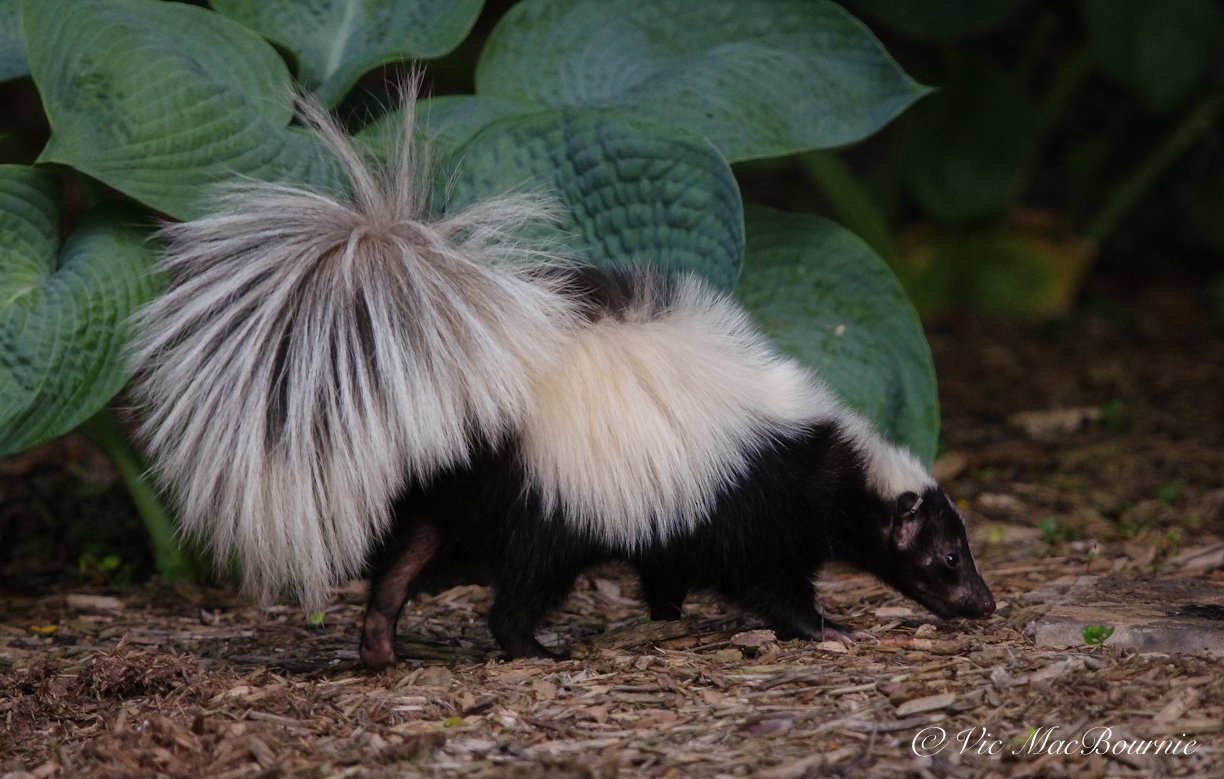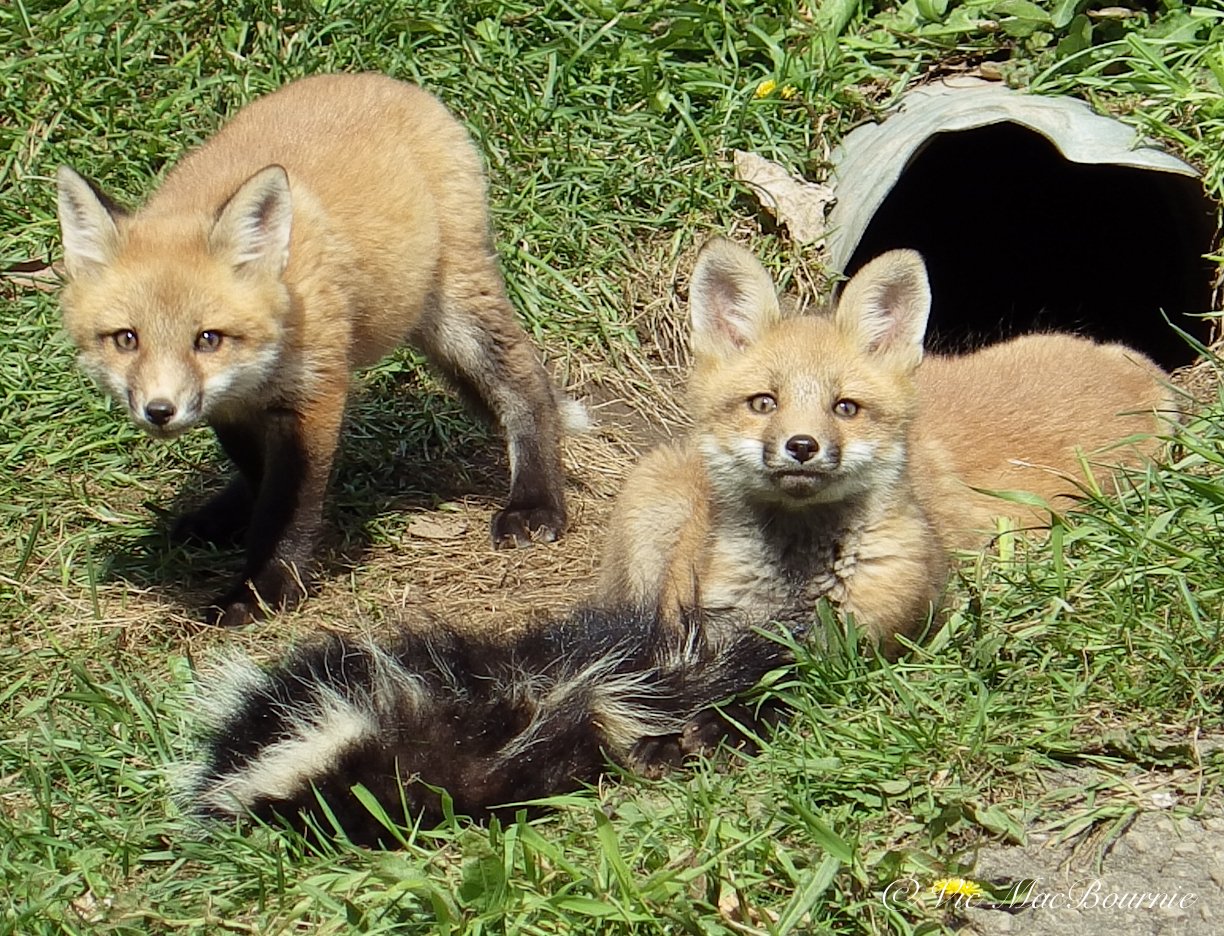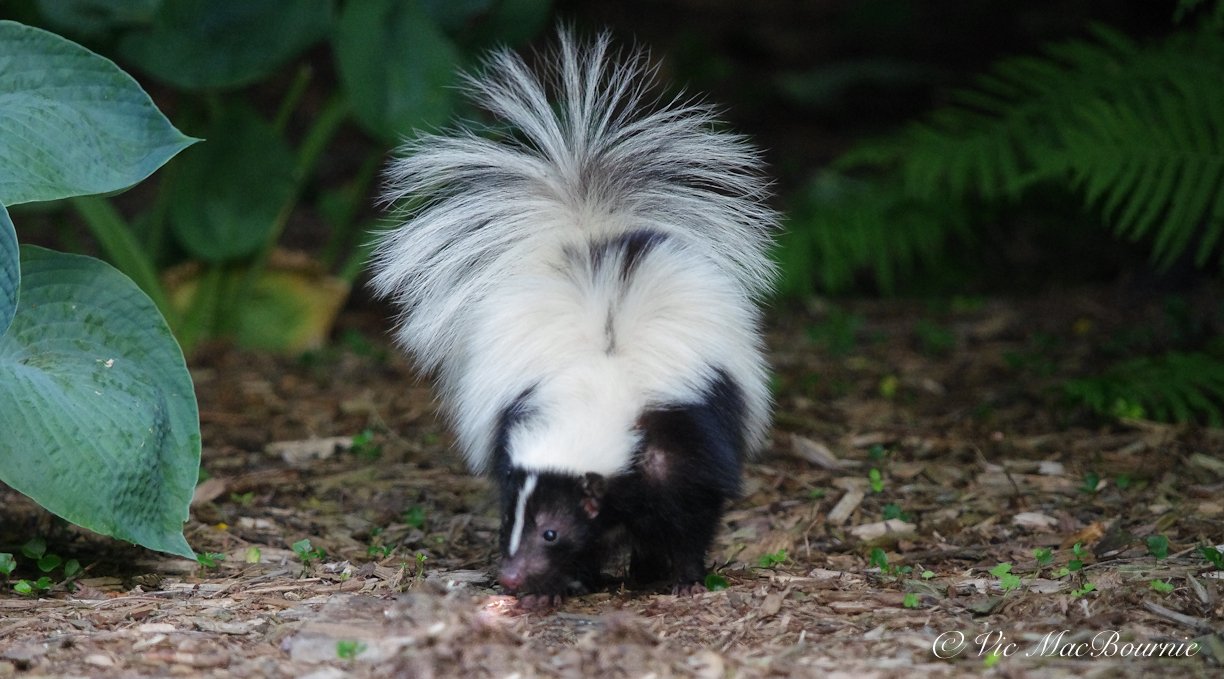How important are skunks in our gardens?
Skunks are extremely beneficial in our gardens helping to reduce unwanted visitors. These gentle creatures pose no threat to us and are rarely seen accept at night.
An evening of garden photography with a friendly skunk
There is no reason to be afraid of a skunk in your backyard. In fact, skunks are gentle creatures that benefit nature and our environment by controlling insect populations and other unwanted garden visitors particularly the dreaded Japanese beetle, cutworms, hornworms and grubs, along with small rodents like mice and moles.
So, I was thrilled to recently spend some time in the garden and add images of skunks to my collection of garden photography wildlife images.
The negative publicity these animals have to live with struck me the other day when I was sitting in my favourite chair in the garden waiting for the neighbourhood fox to show up. The skunk came in from behind me, (paying no attention to the guy sitting very still in the chair) and proceeded to walk by on her way to another part of the garden. She went unnoticed until I caught the white tail out of the corner of my eye. A beautiful, white fluffy tail carried proudly above her for all to see.
A few weeks earlier the skunk decided to pay me a visit on the patio. I would have let it join me on the patio accept my dog, Holly, was sitting beside me. Thankfully she did not notice the skunk until I quietly asked it to leave the patio with a gentle hand motion and soft, persuasive voice. As soon as it saw me, it moved away just as Holly noticed her. I had my hand on her leash to keep her from going after the skunk. That was another fun adventure but much more stressful with a dog at my side.
There’s no mistaking a skunk for, say, a black squirrel. Although they look similar, they carry themselves quite differently. Unlike the sometimes frenetic pace of black squirrels, skunks move slowly and deliberately, possibly because of their relatively poor eyesight and possibly to let other woodland animals know that they are around.
Our gentle skunk spent the evening with me showing off her beautiful tail and looking for grubs and other insects.
I was lucky enough to spend a few minutes with the skunk as it rooted about the garden not far from me (but far enough.) She did not seem bothered by my camera and flash going off with her every movement. Although I did not hide from her, and was not in my Tragopan blind, she seemed quite happy to go about her business.
Actually, because of her poor eyesight, I’m pretty sure she didn’t even realize I was there, especially considering she was more than happy to make a bee-line directly toward me.
That’s the time our evening photographic adventure came to an abrupt end. When she started moving toward me through the grass where I was sitting, all it took was for me to wave my hand slowly and speak gently to her for the little skunk to realize it might be better for her to head in another direction. She abruptly turned around and waddled off into the ferns to go dig up some more grubs.
It was a great garden photography encounter and one I’ll not soon forget.
What’s my favourite garden photography wildlife lens?
What made the encounter a little more unusual was that there was still plenty of light left in the sky and, although I used the flash at times hoping to create a catch light in the skunk’s little eyes, I much preferred the more natural images taken without flash on my Pentax K5 DSLR fitted with my favourite wildlife lens – the FA300mm F4.5. Originally built for film cameras, the smaller sensor in the K5 gives users an effective 420mm F4.5 focal length. I have a 1.4 converter that I use occasionally to get in even closer.
The white stripe starts on its head, runs the entire length of its body and explodes on its magnificent tail.
Skunks help rid your garden of snakes
Did you know that, much like opossums, skunks are immune to snake venom and are more than happy to rid your garden of poisonous snakes. We don’t have any poisonous snakes where I live so I’d prefer our little skunk keeps mice and voles and other critters in check rather than kill the few snakes I’ve seen in the garden.
Keep skunks safe in your backyard
In our backyards, as long as we do NOT use pesticides, skunks are safe from their biggest cause of death.
Weak eyesight means that skunks’ greatest threat is being hit by cars and trucks while they are trying to cross a road. The evidence is hard not to notice when out for a drive. If you don’t see them lying dead on the road, you certainly smell the results of the collision.
In our garden, it is more likely they will fall victim to a Great Horned Owl who are one of the few birds or animals that see the little stinkers as prey. Turns out Great Horned owls’ lack the sense of smell needed to be repulsed by the odour skunks use as a self defence. That makes them easy, slow moving prey for the owls massive claws.
These fox kits seemed to enjoy playing with the dead skunk more than anything else. The den was situated beside a road so I suspect that it was killed by a car and salvaged my the mother fox for her kits. And yes, it did smell but not too bad.
Do fox consider skunks prey?
I have photographed a dead skunk outside an active fox den (see above) but I suspect that the skunk was a victim of a car rather than the mother fox. In fact, I have watched on our trail camera video of a fox and skunk interacting, and neither was looking for a fight.
Although coyotes, foxes, dogs, bobcats, mountain lions, badgers and big owls are known to eat skunks, few put it anywhere near the top of their list of fine dining.
So I don’t think skunks need to fear a fox or other large predators despite the fact that they will eat them if they find a skunk as road kill.
Are skunks a threat to my family?
Skunks are not a threat to our families. They can be an annoyance for dog owners if a family of skunks decide to build a nest under our deck or shed. If you don’t want them there, ensure that efforts are made to keep them from getting under decks by installing fencing that reaches under the ground and makes it difficult for them to dig under it.
It’s not fair to the animals to move them once they have had their families under your deck. Take steps to encourage them to eventually move on from under the deck (playing music in the area of the den), in the meantime, keep your dog away from the area until the skunks leave. Your dog will survive with daily walks or visits to the local dog park until the skunk family moves on its way.
Skunks can carry rabies, but there is apparently no known deaths caused by contracting rabies from a skunk.
Know when to back off
It’s much more likely you will be sprayed by a skunk rather than bitten by one. It’s important to know, however, that skunks don’t just run around spraying people and dogs at the first chance they get.
The skunk sprays a very strong musk oil from 2 anal glands. Even baby skunks, whose eyes have not yet opened, are capable of spraying in self defence.
Spraying is, however, the last thing skunks want to resort to in self defence because, once they use all their spray, they are left completely defenceless for up to ten days – the length of time it takes for the skunk to replace the musk.
Well before a skunk sprays, it will give you a warning to back off. First it stomps its feet on the ground and hisses making it clear it is very uncomfortable with your presence. It will make their bodies in a u-shape before aiming its anal glands at its unfortunate victim. That’s a good time to gently and slowly back off making it clear that you are no threat.
Why did I get sprayed by a skunk?
People are most often sprayed when they surprise a skunk in very close proximity and don’t have time to assure it that you are no threat. It’s a good idea to always expect a skunk as evening sets upon us. Keep an eye out for them when stepping outdoor into your garden and avoid sudden movements that might be mistaken as a threat. If you are with your dog, be sure to keep it on at SHORT LEASE rather than a retractible one that is best left for walks during daylight hours.
Are there different varieties of skunks?
There are actually 12 different species of skunks but not all of them live in North America. Skunks can also be found in South America, Indonesia and the Philippines.
Striped skunks: Most of us are familiar with the cat-sized striped skunk with the white stripe down the middle stretching through its long black tail. They are the ones at home in the woodland as well as in suburban areas.
Spotted skunks: have three white spots on their faces and four more on their backs in addition to six stripes on their tails. These guys are more the size of squirrels and like to climb trees. These are the fellas who stand on their front paws to take aim at their victims. These skunks can be found in the eastern U.S., Mexico, and more rarely in southern Ontario, Canada. The Mexican pygmy spotted skunk is more the size of a rat and is considered the smallest and rarest of our skunk species.
Hooded skunks: An interesting skunk with faces that are framed by a shaggy white mane that covers the tops of their bodies from head to the tip of their tails. It’s unlikely you will come across this species unless you are hiking in rocky areas of southwestern North and Central America where they live in burrows near streams where they survive primarily on insects.
Hog-Nosed skunks: These skunks feature pig-like snouts that help them root for food in their southwestern U.S. homes or in Central and South America where three other species of the hog-nosed skunk can be found.
Stink Badgers: Recently welcomed into the skunk family in 1990 are found in parts of Indonesia, Philippines.
Check out my article on getting prepared in advance for a skunking. Hint: make sure you have hydrogen peroxide and baking soda handy. Forget the tomato juice unless you enjoy smelling like tomato juice and musk.
Why do I smell skunks in mid February?
Why am I smelling skunk every night when there is still snow on the ground? Chances are you are experiencing a female skunk sending a strong message to an amorous male looking to mate or quite possibly two males letting off a little steam over the chance to mate with a female.
Why are we seeing and smelling skunks in the middle of February?
The ground is covered with two feet of snow and skunks seem to be everywhere – we see them roaming through the back and front gardens and smell them on a nightly basis.
What gives?
Turns out female skunks are down right stinkers when it comes to fending off amorous male skunks looking to mate, and all this takes place in mid February right around the time of Valentine’s Day.
That explains the nightly smells we get sitting in our family room – not enough to suggest a full-fledged unleashing of the musky odour experienced when one of our striped friends unleashes on an excitable canine – but enough to get your attention. Especially if it’s right outside the door.
A skunk looking for food in the early evening in the garden. I was out hoping to get a photograph of a fox and the skunk showed up instead with its beautiful tail.
The mating season brings out more of these solitary, elusive animals as they look for partners to begin families. It’s a time when male skunks are more active asserting dominance over other males, while females skunks, who are either not ready to mate or choose not to with a particular male, use their musk glands to fend of advances. These encounters cause both the males and females to spread small amounts of musk – just enough to make us take notice.
You may also be getting a slight odour from under your shed or deck where they are living. Be sure to give them plenty of space and move slowly around them, but they are harmless and very beneficial so it’s much better to learn to live with them than have them removed.
This mid-February odour is not near as strong as you will experience when skunks are killed along the road or when they use it in self defence after being frightened by a neighbourhood dog.
Be prepared for a skunk spray. Check out my post on what to do if your dog or family member has been sprayed by a skunk.
What are skunks’ breeding habits?
Female striped skunks give birth to kits in early spring around April and May after mating in and around mid February. Females can breed in their second summer and give birth to as many as four to seven babies. Older females can come into estrus earlier than younger female skunks and may have litters earlier in spring. Following a sixty-day gestation period, the kits are born in shallow dens or, more likely, under sheds or decks in our yards.
Born blind and deaf and sporting short, fine fur, babies are nursed in the den for about six weeks before venturing out of the den for short excursions with mom. The young skunks are usually weaned from their mother by two months of age.
By fall, the family members have gone their separate ways, travelling as far as 50 kms but usually no more than 5-10 kms, looking for new territory.
Skunks and Great Horned Owls: A deadly combination
We’ve lived in our current home for almost 25 years and have only experienced skunks in the past few years. Where did these skunks come from?
Although we live in a heavily forested area surrounded by conservation lands where you would expect to be living with skunks, up until recently they were nowhere to be seen. I firmly believe that the reason we are experiencing more skunks in our neighbourhood is the result of a severe decline of the Great Horned Owl – skunks’ greatest natural predator.
Typical neighbourhoods offer a cornucopia of food for these shy, inquisitive animals in the form of unprotected garbage cans and pet food left out on decks and back patios. Acres of manicured grass provide skunks with an abundance of grubs, other insects and even mice, just to name a few.
Coyotes, foxes and other predators know enough not to tangle with skunks and will not prey on them unless they are desperate, but Great Horned Owls’ lack of smell allows them to prey on skunks.
This makes the Great horned Owl the primary predator of striped skunks. Although skunks can weigh up to three times more than a typical Great Horned Owl, the deadly talons of the owls make them efficient killers of skunks, whose only real defence is their ability to spray the strong sulphur musk. The owls’ huge, deadly talons combined with their ability to squeeze up to 500 pounds per square inch, means this crushing grip will often kill larger prey like skunks instantly.
The fact that skunks like to travel at night, just when the Great Horned Owls are on the prowl, makes them easy prey. In fact, it is reported that one owl nest contained the remains of nearly 60 skunks.
With an average life span in the wild of between 5-15 years, a Great Horned Owl can certainly do its part in keeping neighbourhoods free of skunks.
That’s good a good reason to do all you can to encourage Great Horned Owls to your neighbourhood. The best way to accomplish this is not to cut down dead trees, especially those that are large enough to provide habitat for these large owls. See my earlier article on the importance of leaving snags in your garden.







